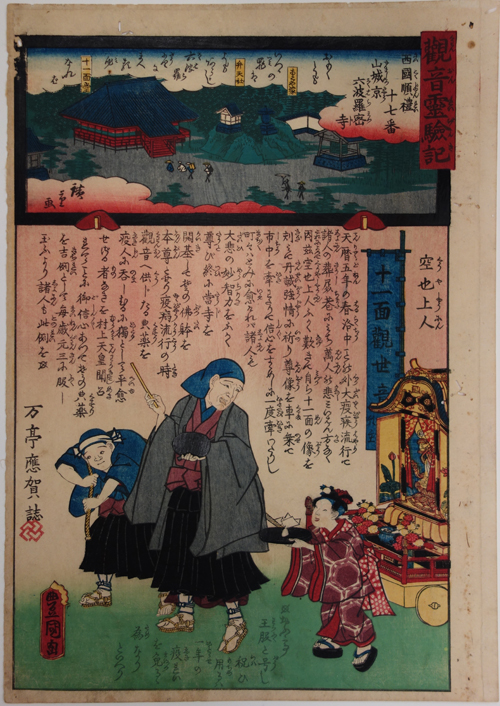Sacred Space and Japanese Art at the Spencer Museum of Art
Entry by YeGee Kwon
This print introduces Rokuharamitsuji in Kyoto as the seventeenth station on the Saikoku pilgrimage route and highlights the story of Kūya (903–972), the prominent traveling monk and founder of the temple. The upper part of the print shows the Rokuharamitsuji precinct, while the lower section depicts Kūya wearing a hood and beating an iron bowl. An attendant monk next to Kūya is pulling a cart with a portable shrine that enshrines a sculpture of an Eleven-headed Kannon. According to legend, in 951 when a terrible plague occurred in Kyoto, Kūya carved this sculpture of Eleven-headed Kannon and pulled it around the city in a cart to stop the plague and pray for the souls of those who died in the plague. Kūya then founded Rokuharamitsuji.
As a sacred space dedicated to Kūya and Kannon, Rokuharamitsuji has attracted believers seeking salvation of themselves, their living family members, and deceased ancestors. Today a Kannon sculpture, said to be by Kūya, is concealed inside the main hall as a secret image, which is only open to the public once every twelve years. Nevertheless, devotees continue to visit the temple to pray to the benevolent deity. Moreover, every August Rokuharmitsuji is packed with people participating in a memorial service calledMandōe (Buddhist lantern festival) that invites spirits of the dead to this location with 10,000 lanterns.

Rokuharamitsuji (Number 17) from the seriesSaikoku sanjūsansho, Kannon reigenki ( Thirty-three temple pilgrimage of the western country, chronicle of Kannon miracles)
Japan, Utagawa Kunisada (1786–1864) and Utagawa Hiroshige II (1826–1869)
1858–1859, Edo period (1615–1868)
Color woodcut
36.4 x 25.5 cm
Private collection
